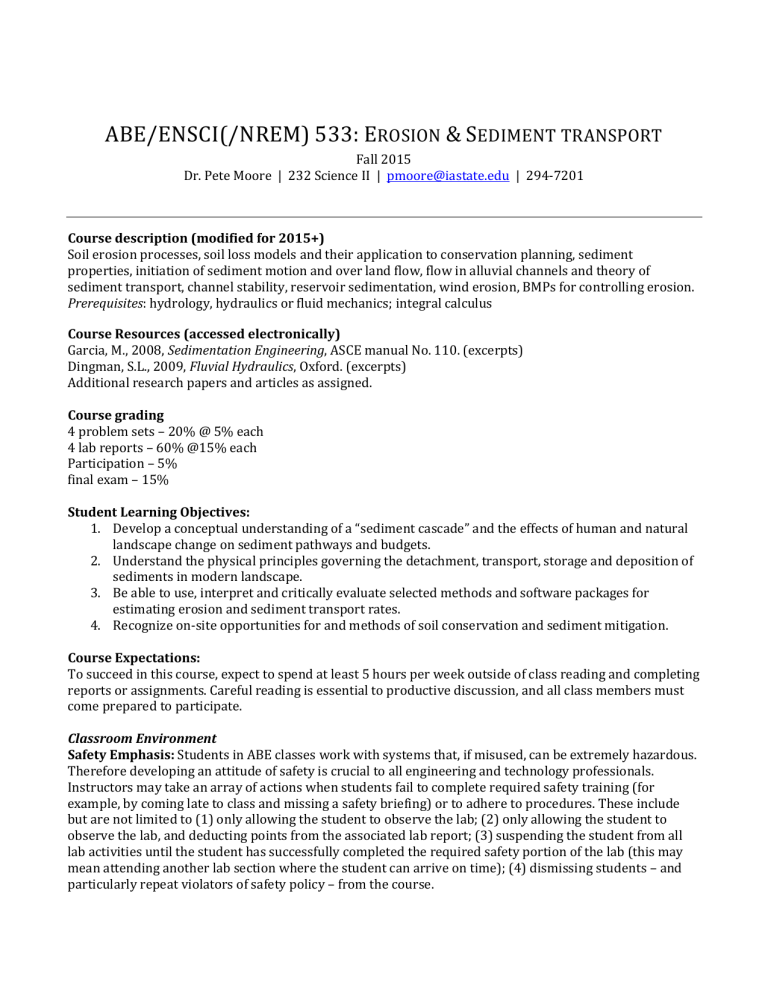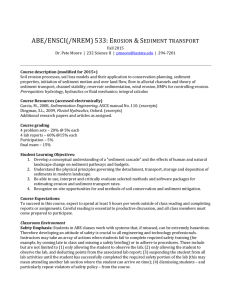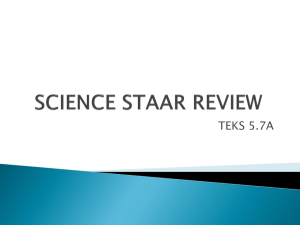ABE/ENSCI(/NREM) 533: E &

ABE/ENSCI(/NREM) 533: E
ROSION
& S
EDIMENT TRANSPORT
Fall 2015
Dr. Pete Moore | 232 Science II | pmoore@iastate.edu
| 294-7201
Course description (modified for 2015+)
Soil erosion processes, soil loss models and their application to conservation planning, sediment properties, initiation of sediment motion and over land flow, flow in alluvial channels and theory of sediment transport, channel stability, reservoir sedimentation, wind erosion, BMPs for controlling erosion.
Prerequisites : hydrology, hydraulics or fluid mechanics; integral calculus
Course Resources (accessed electronically)
Garcia, M., 2008, Sedimentation Engineering , ASCE manual No. 110. (excerpts)
Dingman, S.L., 2009, Fluvial Hydraulics , Oxford. (excerpts)
Additional research papers and articles as assigned.
Course grading
4 problem sets – 20% @ 5% each
4 lab reports – 60% @15% each
Participation – 5% final exam – 15%
Student Learning Objectives:
1.
Develop a conceptual understanding of a “sediment cascade” and the effects of human and natural landscape change on sediment pathways and budgets.
2.
Understand the physical principles governing the detachment, transport, storage and deposition of sediments in modern landscape.
3.
Be able to use, interpret and critically evaluate selected methods and software packages for estimating erosion and sediment transport rates.
4.
Recognize on-site opportunities for and methods of soil conservation and sediment mitigation.
Course Expectations:
To succeed in this course, expect to spend at least 5 hours per week outside of class reading and completing reports or assignments. Careful reading is essential to productive discussion, and all class members must come prepared to participate.
Classroom Environment
Safety Emphasis: Students in ABE classes work with systems that, if misused, can be extremely hazardous.
Therefore developing an attitude of safety is crucial to all engineering and technology professionals.
Instructors may take an array of actions when students fail to complete required safety training (for example, by coming late to class and missing a safety briefing) or to adhere to procedures. These include but are not limited to (1) only allowing the student to observe the lab; (2) only allowing the student to observe the lab, and deducting points from the associated lab report; (3) suspending the student from all lab activities until the student has successfully completed the required safety portion of the lab (this may mean attending another lab section where the student can arrive on time); (4) dismissing students – and particularly repeat violators of safety policy – from the course.
Academic Misconduct: The class will follow Iowa State University’s policy on academic dishonesty.
Anyone suspected of academic dishonesty will be reported to the Dean of Students Office.
Note that there ISU identifies several forms of academic dishonesty including: A student uses or attempts to use unauthorized information in the taking of an exam; submits as his or her own work, themes, reports, drawings, laboratory notes, computer programs, or other products prepared by another person; or knowingly assists another student in such acts of plagiarism. Students found guilty of academic dishonesty in this class face suspension, conduct probation, or reprimand.
Disability Accommodation Policy: Iowa State University is committed to assuring that all educational activities are free from discrimination and harassment based on disability status. All students requesting accommodations are required to meet with staff in Student Disability Resources (SDR) to establish eligibility. A Student Academic Accommodation Request (SAAR) form will be provided to eligible students.
The provision of reasonable accommodations in this course will be arranged after timely delivery of the
SAAR form to the instructor. Students are encouraged to deliver completed SAAR forms as early in the semester as possible. SDR, a unit in the Dean of Students Office, is located in room 1076, Student Services
Building or online at www.dso.iastate.edu/dr/ . Contact SDR by e-mail at disabilityresources@iastate.edu
or by phone at 515-294-7220 for additional information.
Dead Week: For each Fall and Spring semester, the last full week of classes before final examinations is designated as Dead Week. The intent of Dead Week is to establish a one-week period of substantial and predictable study time for undergraduate students. During the Dead Week period, regular lectures are expected to continue, including the introduction of new content, as deemed appropriate by the instructor.
The restrictions established by this Dead Week policy are:
Due dates for mandatory graded submissions of any kind that fall within Dead Week must be listed on the syllabus provided at the start of the course.
Mandatory final examinations may not be given during the Dead Week period except for laboratory courses or courses that meet weekly and for which there is no contact during the normal final examination week.
Harassment and Discrimination: Iowa State University strives to maintain our campus as a place of work and study for faculty, staff, and students that is free of all forms of prohibited discrimination and harassment based upon race, ethnicity, sex (including sexual assault), pregnancy, color, religion, national origin, physical or mental disability, age, marital status, sexual orientation, gender identity, genetic information, or status as a U.S. veteran. Any student who has concerns about such behavior should contact
{course instructor}, the Associate Chair of Teaching (Professor Raj Raman, rajraman@iastate.edu
,
515.294.0465), Student Assistance at 515.294.1020 or email dso-sas@iastate.edu
, or the Office of Equal
Opportunity and Compliance at 515.294.7612.
Religious Accommodation: If an academic requirement of this class conflicts with your religious practices and/or observances, you may request reasonable accommodations. Your request must be in writing, and your instructor or supervisor will review the request. You or your instructor may also seek assistance from the Dean of Students Office or the Office of Equal Opportunity and Compliance .
Contact Information: If you are experiencing, or have experienced, a problem with any of the above issues, email academicissues@iastate.edu
.
TENTATIVE SCHEDULE week Day Topic
1
(8/25-
27)
Class
Course philosophy; sediment cascade introduction: the big picture
Lab Comp: Intro to computing tools: Matlab and
Whitebox GAT
2
(9/1-3)
3
(9/8-
10)
Class Fluid properties; conservation laws; fluid constitutive properties
Lab Field: tour of a sediment cascade: Richardson
Branch, Boone County
Class
Soil properties and characterization relevant to erosion; rainfall and runoff
4
(9/15-
17)
Lab Field: overland flow and soil erosion, Worle Creek watershed
Class
Fluid forces on particles; intro to critical shear stress; detachment and transport processes
5
(9/22-
24)
6
(9/29-
10/1)
Lab Comp: plot-scale soil loss
Class Sheet and rill erosion; excess shear-stress; stream-power
Lab Comp: process-based soil loss
Class
Wind erosion; soil erosion model comparison
7
(10/6-
8)
Lab Comp: WEPS
Class
Gullies; erosion control principles and structures
8
(10/13-
15)
Lab Field: Hickory Grove gullies
Class
More on sediment budgets; sediment delivery to channels & storage
9
(10/20-
22)
10
(10/27-
29)
11
(11/3-
5)
12
(11/10-
Lab TBA
Class Fluvial geomorphology; hydraulic geometry and regime
Lab Field: bedforms and channel units
Class
Hydrology; flow duration
Lab
Class
Lab
Class
Field: bed material measurement & sampling
Shields criteria & incipient motion
Comp: TBA
Bedload transport relationships
Assignment
Amundson et al., 2015
Owens, 2005
Matlab primer
Dingman, ch.4 (p. 137-158)
PS1 (RB watershed)
Bryan, 2000
PS2 (Worle site map)
Garcia ch.2 (p. 24-44)
Leonard & Richard, 2004
Clark & Wynn, 2007
LR1: site assessment
Wagner, 2013 skim Garcia, ch. 17 skim NEH TS14P
Bergonse and Reis, 2011
Wells et al., 2009
LR2: soil loss model
Walling, 1983
Parsons et al., 2006
Trimble & Crosson, 2000
Garcia ch. 6
Dingman p. 50-93 skim Garcia ch. 5; PS3
Garcia ch. 2 (p. 44-60)
Garcia ch. 2 (p. 60-99)
12)
13
(11/17-
19)
14
(12/1-
3)
Lab Comp: TBA
Class
Suspended-sediment transport; sediment rating curves
Lab Comp: sediment duration analysis
Class
Lane’s balance; channel evolution phenomena
15
(12/8-
10)
16
(12/15-
17)
Lab Computer: HEC-RAS
Class
Reservoir sedimentation
Lab Computer: TBA
Final exam TBA
PS4
Garcia ch. 2 (p. 99-129)
LR3: bedload transport
Garcia ch. 7
Garcia ch. 12
LR4: channel design





